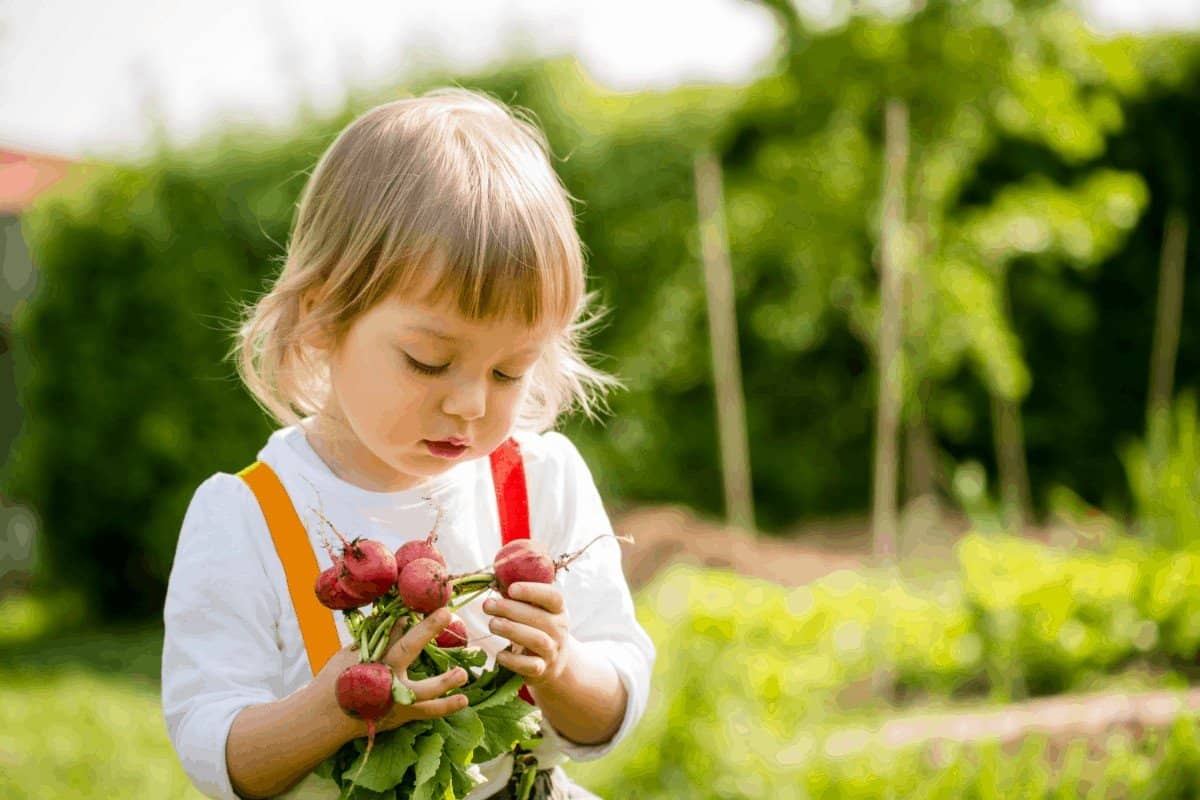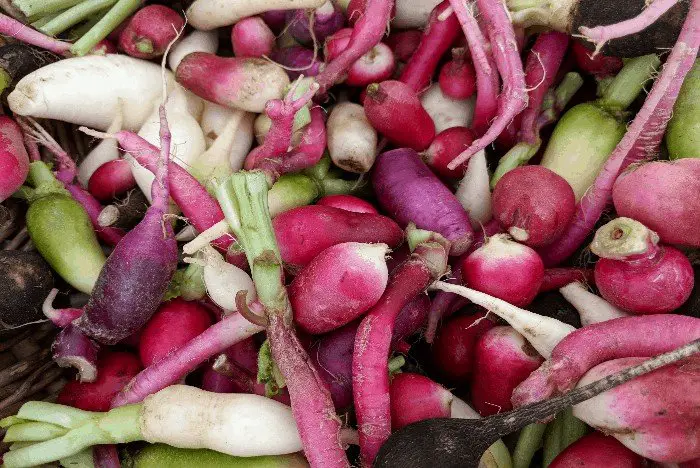Last Updated on December 30, 2021 by
Radishes are strong root vegetables in the same scientific family as broccoli and cauliflower. Many varieties have a pungent smell or flavor which makes them distinct and often leaves people either vehemently for or against the vegetable. They grow best in cool seasons and will sprout fast, often taking less than a month to appear and be ready for consumption.
Since radishes have so much variety, they can be planted in almost any season. However, most professionals recommend planting these succulent vegetables in the spring, late summer, and even in the winter depending on the type and climate.
A major issue for many gardeners is trying to figure out when these vegetables are ready to pick. Although some people like to base their habits off of intuition or how they’ve handled other vegetables, this doesn’t always work for the radish. Because it is a rapid grower and has many different types, this guide will explain just when to pull the radish out of the ground.
How to Store Picked Radishes
Harvesting radishes is a simple process. The first step to figuring out when your vegetables are ready to pick is to make sure you know which type is planted in the garden. There is a broad range available. Most can be harvested around three weeks after the initial planting, but some winter varieties like daikon can be kept in the ground for months so they grow healthy and large.
Variety obviously affects when the radish will be ready to pick. Most can be separated into two categories: Spring or Winter. In general, the spring variety can be harvested much sooner, but will also be quite a bit smaller. Winter types can be planted and grown for longer periods of time, but will also be large once removed from the ground.
There are tons of options available, so be sure you know what you’re growing before you start to collect vegetables. Some of the most common include:
- Sparkler – A red radish with a white interior and tip
- Daikon – Long white radishes are grown in the winter
- Cherry Belle – The typical round, red radish that is used in salads and other recipes
- French Breakfast – Crispy and pungent, but delicious
- White Beauty – A small white radish with a sweet flavor
- Fire and Ice – A distinct model that is half red and half white
The greatest problem gardeners might encounter with the radish is having the plant rot from neglect. Too many leave the plant in the ground for far too long. Don’t wait more than three or five weeks to get those spring varieties, but feel free to live winter options in the ground for a couple of months.
It’s important to grab the vegetables at the right time, otherwise, the radish becomes woody and full of pits. If you’re trying to figure out a good time of day to grab the veggies, then harvest shortly after a rainstorm or after watering the vegetables. This way, the soil is soft and it isn’t difficult to get the radishes out of the ground.
How to Pick Properly
Picking radishes is actually quite simple, and there is no secret. All you have to do is grasp the plant by the leaves that grow above ground and gently pull the vegetable out of the dirt. If for some reason, the ground is hard or has become overgrown by moss, you can use a small trowel to gently pick through the dirt until it is loose enough to remove the vegetable.
If you are trying to pick the heavier, thicker winter radishes, then you might need to use a garden fork. A garden fork is similar to a trowel but has several long, pointed tines that can help break up the earth. It might be necessary to dig above and around the radish to avoid tearing the greens from the vegetable. Remember to wet the soil if you’re struggling.
Once the radishes are harvested, wash them thoroughly before attempting to eat or store them. The vegetable needs to be scrubbed as much as possible, as dirt builds up on the outside. The radish greens are edible and work well in salads, so remove them from the radish root itself. They can last for three days, so rinse them and store them in the fridge.
As for the rest of the radish, most individuals prefer to chop off the top and bottom, where the roots can grow. Wash again, store the radishes in a plastic bag, and then put them in the fridge as well.
How to Store Picked Radishes
Once radishes have been removed from the ground and cleaned, there is actually little that needs to be done to store them. They work well when kept in the fridge because the cool temperature helps protect the vegetable from decay. If you want, the radish itself (not the greens) can be kept in the pantry. If the greens aren’t stored in a cool environment, they will wilt quickly.
If you want to get seeds from the radishes before storage, do so before you start to wash the vegetables. To avoid cross-pollination, you only want to get seeds from vegetables that were planted with their own variety. For example, don’t grab seeds from Sparklers that were planted with French Breakfast, as this can result in radishes that have lost their distinct characteristics.
Conclusion
In short, be prepared to harvest spring options after 3-5 weeks, and winter ones after 2-3 months. If you’re unsure of what variety you have, try to match the seeds or a sample radish (pulled early) to the standard descriptions and pictures. If you still can’t tell, then hope the vegetable was put in the ground during the right season and base your harvesting decision off of that information.
Happy gardening!
FAQs
How do I know when my radishes are ready to be picked?
The best way to know is by looking at the radish itself. One way is by holding a radish in your hand and gently squeezing it, if it yields easily, it's ready for picking. Another way is using a potato to test the color of the stem. If you can see the stem through a hole in the potato, then you know that it is ready for picking.
You should not wait until they turn brown because this will cause them to spoil faster than they would have otherwise.
Can you eat radish leaves?
Radish leaves are the edible leaf of a radish plant. They are typically discarded by chefs and herbivives because they think it is unappetizing to eat this vegetable's leaves. However, it is not true that you cannot eat them raw or in cooked dishes; you just have to prepare them differently in order to taste good.
Why do you soak radishes in water?
Many people are left wondering what is the point of soaking radishes in water. The answer is that this process helps to make the radish more flavorful, tender, and palatable. It also helps to remove some of the bitterness that may be present in the radish as well as remove some of the dirt off of it.
What month are radishes harvested?
Radishes are harvested in the month of May.
Why are my radishes growing above ground?
Radishes are often grown in a garden. However, sometimes they grow above the ground instead of below it due to unusual circumstances.
This might happen when the radishes have been buried too deeply underground or if the soil is too compacted. Also, if you're growing them in a pot, this can also happen because there are no roots for them to grow from.
Why are my radishes so small?
In some cases, radishes are just smaller than we expect. This could be because the seeds were tiny and since radishes take longer to grow, they would grow up big by the time it's harvest time.
What causes your radishes to be so small?
Overgrowing: When your radish plants grow too tall, they will start choking out other plants, preventing sunlight from reaching them until they've naturally shrunk back down again. Competition: Other nearby plants competing for sun can also cause this
What happens if you let radishes grow too long?
If you leave them too long, radishes will rot and the leaves will turn yellow before falling off. The stems may also develop sores or rots of their own which makes it difficult for the plant to continue living.
Radishes grow best when the soil is moist and not too hot. If the soil is too wet, they will rot; if the soil is too dry, they will be burnt and tasteless.
A longer growing season allows for more time for these radishes to develop a strong root system that lets them grow bigger and of course taste better. However, over-long growing seasons can be problematic as well.
The bottom line: Radish length should be monitored in order to ensure that they don't get overly long and damaged in terms of taste or nutritional value.
How many radishes does a plant produce?
Radishes are one of the most popular vegetables grown in gardens and farms across the world. Most people grow them for their light, fresh taste and quick growing rate.
How many radishes does a plant produce?
It depends on how much water it gets, how much fertilizer it has, and other factors.
Tony Manhart is a passionate gardener who has been tending to gardens for over 20 years. He takes pride in creating beautiful outdoor spaces with plants, trees, and shrubs that can thrive in any environment. He loves to share his knowledge with others and has taught classes on gardening basics and advanced techniques. He is committed to sustainability, using natural and organic methods to create and maintain gardens. He also works with local organizations to create green spaces for communities. When he’s not gardening, Tony enjoys hiking, reading, and spending time with his family.


